Texium
Administrator
       
Posts: 4515
Registered: 11-1-2014
Location: Salt Lake City
Member Is Offline
Mood: PhD candidate!
|
|
Synthesis of Isobutyl Bromide
This was adapted from the procedure for the preparation of n-butyl bromide found in Unitized Experiments in Organic Chemistry by Brewster et
al.
Reagents
35 mL distilled water
35 mL 96% sulfuric acid
37 mL (30 g) isobutanol
41.7 g sodium bromide dihydrate
Anhydrous calcium chloride
Procedure
1. Set up a 250 mL round bottom flask in an ice bath on a stirring hot plate.
2. To the flask, add a magnetic stir bar and 35 mL cold distilled water.
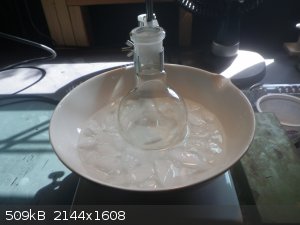
3. Slowly add 35 mL 96% sulfuric acid to the flask with stirring, and then 37 mL of isobutanol. Remove the ice bath once this is complete.
4. Set up an efficient reflux condenser, such as a Friedrich's with cold water. Set aside.
5. Increase the stirring speed and then quickly add 41.7 g sodium bromide dihydrate, after making sure that there are no clumps in it.
6. Attach the reflux condenser to the boiling flask and turn on the heating.
7. Bring the contents of the flask to a boil and allow it to reflux for 45 minutes.
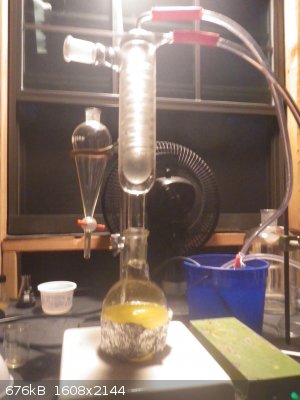
8. After the reflux period, turn off the hotplate and allow the contents of the flask to cool. There should be two distinct layers.
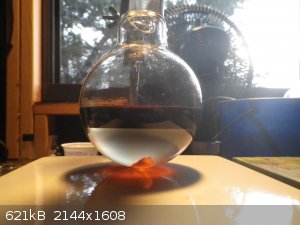
9. Once the apparatus is cool enough to handle, remove the reflux condenser and replace it with a still head and Liebig condenser for simple
distillation.
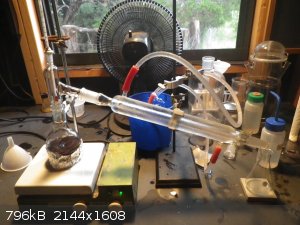
10. Turn the heating back on and quickly distill the mixture, which will form two layers in the receiving flask. Once all of the distillate is
collecting in the upper aqueous layer, stop the distillation.
11. Pour the distillate into a separatory funnel. Collect the bottom layer, which is wet isobutyl bromide in a small flask and add a small spatula
full of anhydrous calcium chloride prills. Stopper the flask and let it sit for about an hour, or until the liquid is no longer cloudy.
12. Decant the dried isobutyl bromide into a 100 mL round bottom flask and set up a simple distillation apparatus. Make sure that all of the glassware
is very dry.
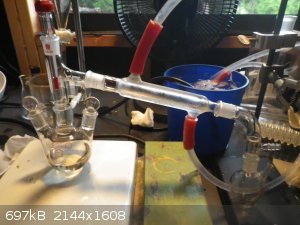
13. Distill the dried isobutyl bromide until there is almost nothing left in the boiling flask, but do not boil to dryness. If the distillate still
seems cloudy, it may be dried and distilled a second time. Store the final product in an amber glass bottle.
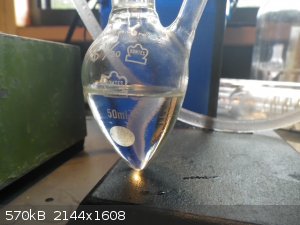 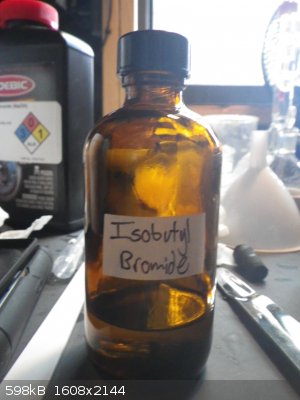
Results
Theoretical yield: 41.10 g (based on sodium bromide)
Actual Yield: 27.80 g
Percent Yield: 67.6%
Discussion
Please see further posts in this thread for more information.
Isobutyl bromide has a strong, heavy odor resembling butterscotch, but with a somewhat sharp character. It is a clear, colorless liquid with a high
index of refraction.
The product was characterized by testing with silver nitrate. A dilute solution of silver nitrate was prepared in a test tube, and one drop of the
isobutyl bromide was added to it. The isobutyl bromide immediately sunk to the bottom of the test tube, and a second later a white precipitate of
silver bromide began to form. I do not have the means to characterize the product more accurately or assess its purity quantitatively.
I'm not fully sure why my yield was so low. My suspicion is that since I used a magnetic stir bar during the reflux and distillation (out of habit, as
the procedure in the textbook doesn't call for one) contact between the water and isobutyl bromide was much greater than it would have been if a stir
bar wasn't used. Mechanical losses were negligible.
------
Since this is my first real organic chemistry write-up, I'd be happy to hear constructive criticism and advice on how to improve future write-ups.
Thanks! 
[Edited on 7-10-2016 by zts16]
|
|
|
Crowfjord
Hazard to Others
  
Posts: 390
Registered: 20-1-2013
Location: Pacific Northwest
Member Is Offline
Mood: Ever so slowly crystallizing...
|
|
It seems you may not have used enough sodium bromide. 30 grams of isobutanol corresponds to about 0.41 mol, while 41.7 grams sodium bromide dihydrate
would be 0.30 mol. You must have calculated for an equimolar amount of anhydrous sodium bromide. Regardless, an excess of bromide salt (I usually use
about 1.2 to 1.5 equivalents) would help to boost the yield of the alkyl bromide.
|
|
|
Texium
Administrator
       
Posts: 4515
Registered: 11-1-2014
Location: Salt Lake City
Member Is Offline
Mood: PhD candidate!
|
|
Quote: Originally posted by Crowfjord  | | It seems you may not have used enough sodium bromide. 30 grams of isobutanol corresponds to about 0.41 mol, while 41.7 grams sodium bromide dihydrate
would be 0.30 mol. You must have calculated for an equimolar amount of anhydrous sodium bromide. Regardless, an excess of bromide salt (I usually use
about 1.2 to 1.5 equivalents) would help to boost the yield of the alkyl bromide. |
Yes, that does seem
rather odd now that you mention it. However, it was not a mistake to use a less than stoichiometric amount of sodium bromide. The procedure from the
book that I was following specifies 41.7 grams of sodium bromide and 30 grams of butanol. I assumed that there was a good reason for this, but perhaps
not.
|
|
|
Magpie
lab constructor
    
Posts: 5939
Registered: 1-11-2003
Location: USA
Member Is Offline
Mood: Chemistry: the subtle science.
|
|
I have made n-butyl bromide several times. I have always used the procedure in Pavia, usually at 4X scale. As Crowford stated, the Pavia procedure
specifies a mole ratio of 1.5 for NaBr:n-butyl alcohol. When I first did this in school at the book scale (1X) my yield was 60.6%. Did you base
your yield on the limiting reagent?
Also, Pavia specifies only one distillation. Washes provide the initial cleanup.
The single most important condition for a successful synthesis is good mixing - Nicodem
|
|
|
Texium
Administrator
       
Posts: 4515
Registered: 11-1-2014
Location: Salt Lake City
Member Is Offline
Mood: PhD candidate!
|
|
Quote: Originally posted by Magpie  | I have made n-butyl bromide several times. I have always used the procedure in Pavia, usually at 4X scale. As Crowford stated, the Pavia procedure
specifies a mole ratio of 1.5 for NaBr:n-butyl alcohol. When I first did this in school at the book scale (1X) my yield was 60.6%. Did you base
your yield on the limiting reagent?
Also, Pavia specifies only one distillation. Washes provide the initial cleanup. |
Ok, that's embarrassing.
Not only did I base my yield on isobutanol despite sodium bromide being the limiting reagent, I also used the wrong value for the molar mass of
isobutyl bromide, so my yield was actually quite a bit better than what I had put there originally. Even based on isobutanol it's 50%. I'm editing the
original post to reflect reality, but I will paste the original incorrect figures here for context: Theoretical yield: 70.04 g Actual Yield: 27.80 g
Percent Yield: 39.7%
Next time I need to make an alkyl bromide though, I'll try the procedure from Pavia. The way you describe it makes it sound much better. Thanks again
for the physical copies of Pavia and Brewster, by the way. 
[Edited on 7-10-2016 by zts16]
|
|
|
AlChemicalLife
Harmless

Posts: 37
Registered: 18-1-2011
Member Is Offline
Mood: happy and ready for science
|
|
Sorry to bring this thread back from the dead but I didn't want to waste space and start a new one .
Would this be a good "beginner " organic chemistry experiment to conduct ?
While I've been on and off doing chemistry experiments for a while , I still classify my self a beginner and would like to take it slow again and keep
the big problems to a minimum. Like and experiment that if I screw up I'm not gonna end up killing my self and my neighbors (or their "free roam
chickens " )
|
|
|